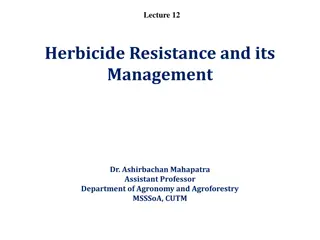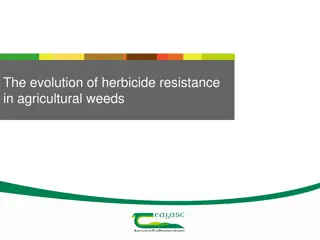Understanding Herbicide Mixtures, Compatibility, and Applications in Agriculture
Herbicide mixtures play a crucial role in weed control by combining different herbicides for enhanced efficacy. Various types of herbicide mixtures, including factory pre-mix and tank mix, offer advantages such as broad-spectrum weed control and delayed resistance development. Compatibility of herbicides with other agrochemicals is important to avoid interactions that may affect efficacy. Knowledge of synergistic and antagonistic interactions can help optimize plant protection programs.
Download Presentation

Please find below an Image/Link to download the presentation.
The content on the website is provided AS IS for your information and personal use only. It may not be sold, licensed, or shared on other websites without obtaining consent from the author. Download presentation by click this link. If you encounter any issues during the download, it is possible that the publisher has removed the file from their server.
E N D
Presentation Transcript
Lecture 10 Herbicide Mixture and Utility in Agriculture, Herbicide Compatibility with Agro-chemicals and their Application Dr. Ashirbachan Mahapatra Assistant Professor Department of Agronomy and Agroforestry MSSSoA, CUTM
Herbicide mixture It involves mixing of two or more herbicides used for effective and economical weed control. Mechanical and chemical mixing of two or more herbicides having different mode of action and varying level of activity and selectivity forms herbicide mixtures. Herbicides of the same class or different classes having similar mode of action are not ideal for herbicidal mixture. Herbicides having similar spectrum of weed control should not be opted for mixing. Advantages of Herbicide Mixture 1. Controls broad spectrum weeds. 2. Prevents shift in weed flora. 3. Delays development of resistance in weeds. 4. Increases the weed control efficiency. 5. Reduced dosage of herbicides per unit area. 6. Because of reduced rate of application reduced residue in crop and environment.
Types of herbicide mixtures 1) Factory mix/premix/readymix It is the mixture of desired herbicides prepared in the factory itself with definite proportions. It is formulated by the manufacturer Examples: Isoguard plus (Isoproturon + 2,4-D); Aniloguard plus (Anilophos + 2,4-D); Primaguard (Atrazine + Metolachlor); Atlantis (Mesosulfuron-methyl + Iodosulfuron methyl sodium); Almix (Metsulfuron methyl + chlorimuron ethyl) used in rice; Pursuit plus (Pendimethalin + Imazethapyr) 2) Tank mix/ field mix herbicide mixtures It is mechanical mixing of two or more herbicides before their application in the field. Examples: Atrazine + Alachlor Atrazine + Pendimethalin Isoproturon + Tralkoxydim Sethoxydim + Chlorsulfuron
Compatibility of herbicides with other agro chemicals and their application Simultaneous or sequential application of herbicides, insecticides, fungicides, antidotes, fertilizers etc., is followed in a single cropping season. These chemicals may undergo a change in physical and chemical characters, which could lead to enhancement or reduction in the efficacy of one or more compounds. The interaction effects were seen much later in the growing season or in the next season due to build up of persistent chemicals or their residues in the soil. Knowledge on the interactions of various chemicals can be helpful in the formulation and adoption of a sound and effective plant protection programme. It can also help to exploit the synergistic and antagonistic interactions between various pesticides for an effective eradication of weed and other pest problems. When two or more chemicals accumulate in the plant, they may interact and bring out responses. These responses are classified as additive, synergistic, antagonistic, independent and enhancement effects.
i) Additive effect: It is the total effect of a combination, which is equal to the sum of the effects of the components taken independently. (AB) = (A) + (B) ii) Synergistic effect: The total effect of a combination is greater or more prolonged than the sum of the effects of the two taken independently. Eg. The mixture of 2,4-D and chlorpropham is synergistic on monocot species generally resistant to 2,4-D. Similarly, low rates of 2,4-D and picloram have synergistic response on Convolvulus arvensis. Atrazine and alachlor combination, which shows synergism is widely used for an effective control in corn. (AB) > (A) + (B) iii) Antagonistic effect: The total effect of a combination is smaller than the effect of the most active component applied alone. Eg. Combination of EPTC with 2,4-D, 2,4,5-T or dicamba have antagonistic responses in sorghum and giant foxtail. Similarly, chlorpropham and 2,4-D have antagonism. When simazine or atrazine is added to glyphosate solution and sprayed the glyphosate activity is reduced. This is due to the physical binding within the spray solution rather than from biological interactions within the plant. (AB) < (A) + (B) iv) Independent effect: The total effect of a combination is equal to the effect of the most active component applied alone. If (A) > (B) then (AB) < (A) v) Enhancement effect: The effect of a herbicide and non-toxic adjuvant applied in combination on a plant is said to have an enhancement effect if the response is greater than that obtained when the herbicide is used at the same rates without the adjuvant. Eg. Mixing Ammonium sulphate with glyphosate.
1. Herbicide-Moisture interaction Soil applied herbicides fail when there is a dry spell of 10-15 days after their application. Pre-emergence herbicides may be lost by photo-decomposition, volatilization and wind blowing while some amount of water is desirable to activate the soil applied herbicides, excess of it may leach the herbicide to the crop seed and root zone. This may injure the crops and on other side, results in poor weed control. Heavy showers may wash down herbicides from the foliage. Continuous wet weather may induce herbicide injury in certain crops by turning them highly succulent. Eg. Maize plants are normally tolerant to Atrazine but they become susceptible in wet weather, particularly when air temperature is low. Extra succulence has been found to increase atrazine absorption and low temperature decreases its metabolism inside the plants. Quality of water used may also determine herbicide action. Dusty water reduces action of paraquat. Calcium chloride rich water reduces glyphoste phytotoxicity.
2. Herbicide-Insecticide interaction These chemicals are usually not harmful at recommended rates. The tolerance of plants to a herbicide may be altered in the presence of an insecticide and vice versa. The phytotoxicity of monuron and diuron on cotton and oats is increased when applied with phorate. Phorate interacts antagonistically with trifluralin to increase cotton yield, by stimulating secondary roots in the zone of pesticide incorporation. Propanil interacts with certain carbamate and phosphate insecticides used as seed treatments on rice. But chlorinated hydrocarbon insecticides as seed treatment have not interacted with propanil. When propanil is applied at intervals between 7 and 56 days after carbofuron treatment, it results in greater injury to rice vegetatively.
3. Herbicide-Pathogens / Fungicides interaction Herbicides interact with fungicides also. Dinoseb reduces the severity of stem rot in groundnut. In sterilized soil, chloroxuron is not causing any apparent injury to pea plants, while in the presence of Rhizoctonia solani in unsterilized soil it causes injury. Oxadiazon reduces the incidence of stem rot caused by the soil borne pathogen Sclerotium rolfsii L. in groundnut. Diuron and triazine which inhibit photosynthesis may make the plants more susceptible to tobacco mosaic virus. On the other hand, diuron may decrease the incidence of root rot in wheat.
4. Herbicide- Fertilizer interaction Herbicides have been found to interact with fertilizers in fields. E.g., fast growing weeds that are getting ample nitrogen show great susceptibility to 2,4- D, glyphosate than slow growing weeds on poor fertility lands. The activity of glyphosate is increased when ammonium sulphate is tank mixed. Nitrogen invigorate (put life and energy in to) the meristamatic activity in crops so much that they become susceptible to herbicides. High rates of atrazine are more toxic to maize and sorghum when applied with high rates of phosphorus.
5. Herbicide- Microbes interaction Microorganisms play a major role in the persistence behaviour of herbicides in the soil. The soil microorganisms have the capacity to detoxify and inactivate the herbicides present in the soil. Some groups of herbicides are more easily degraded through microbes than others. The difference lies in the molecular configuration of the herbicide. The microorganisms involved in herbicide degradation include bacteria, fungi, algae, moulds etc. out of which, bacteria predominates and include the members of the genera Agrobacterium, Arthrobacter, Achromobacterium. Bacillus, Pseudomonas, Streptomyces, Flavobacterium, Rhizobium etc. The fungi include the of the genera of Fusarium, Penicillium etc.























